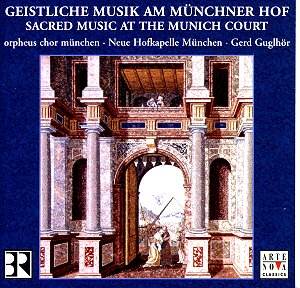The two composers whose works are recorded here
both worked at the court chapel in Munich. This chapel was famous
throughout Europe in the second half of the 16th century, when
Orlandus Lassus was ‘Hofkapellmeister’. After his death, in 1594,
the status of the chapel deteriorated. It was Johann Caspar Kerll,
‘Hofkapellmeister’ from 1656 - 1673, who revived the chapel. He
was educated as an organist, and went to Rome to study with Carissimi
and Frescobaldi. He developed into one of the main composers of
organ music in Germany, whose works were closely studied by Bach
and Handel. In his vocal music he introduced the new ‘concertato’
style in Munich, but made use of the ‘old-fashioned’ polychoral
style – invented and developed in Venice - as well. Both elements
are present in the Missa Superba, written for two vocal and instrumental
choirs.
Rupert Ignaz Mayr was educated as a violinist,
and started his career at the Prince-Bishop's court in Freising.
He came to the court in Munich in 1683, and was sent to Paris
by the then Elector Max Emanuel. There he met Lully, who strongly
influenced his writing for the violin. In 1685 he was appointed
composer and ‘First Violinist and Musician of the Chamber’ in
Munich. In 1706 he returned to Freising to become ‘Hofkapellmeister’
at the court. In his music Mayr attempts to unite the French and
Italian styles. The motet Jubilate Deo, with which this CD starts,
clearly reflects the influence of the French style. The Salve
Regina, on the other hand, is a late baroque motet in Italian
style, with the music closely following the text.
This is just very fine music, which is representative
of the kind of music written in the second half of the 17th century
- a period which is not getting the attention it deserves. And
whereas Kerll's vocal works have been recorded before, as far
as I can remember it is the first time I have heard any vocal
music by Mayr. Therefore we should be thankful for this recording.
The performance is stylish: period instruments
are used, played with competence by the Neue Hofkapelle München,
among whose members are players who have also played with ensembles
like Musica antiqua Köln. Apart from some technical insecurities
here and there, the singers give very good performances as well.
And the choir makes a good impression too.
But: I am somewhat disappointed by this recording.
The main reason is that the concept of the performances seems
to be wrong to me. The music here is considered to be written
for soloists, choir and orchestra. I believe that the music clearly
indicates a performance by a vocal and instrumental ensemble.
There are no long soli here, just relatively short passages for
solo voices, which are clearly meant to be sung by members of
the ensemble. Since the choir is relatively large - that is how
it sounds; nothing is said about the number of singers - the transition
between soli and tutti is unnatural. And the balance between choir
and instruments is anything but ideal. The choir, despite all
its obvious qualities, also lacks the flexibility to deal with
some sudden shifts in rhythm.
There are other things which are questionable.
The order of pieces on this recording puzzles me. Why does the
CD start with Mayr, who is the youngest of the two? The Vesper
psalms by Mayr are put together like a Vesper for the Blessed
Virgin Mary - fine, but why is it interrupted by a setting of
the Salve Regina and the Psalm Confitebor tibi Domine, which have
nothing to do with the Vespers? But one could argue that it doesn't
matter that much, since these are not a 'real' Vespers anyway:
the antiphons which precede and follow every part of the Vespers
are lacking here. And why is the Italian pronunciation of the
Latin texts used?
Gerd Guglhör has written the informative
liner notes. Unfortunately the person who translated them into
English seems not quite to understand what he is dealing with:
the first piece of the CD, Jubilate Deo by Mayr, is described
in the English version as "the opening section", wrongly suggesting
that this is the first part of the Vespers.
To sum up: an interesting recording, sympathetically
performed, but showing some basic misunderstandings regarding
the performance practice of sacred music in the 17th century.
Johan van Veen
